2013 HONDA CROSSTOUR brake
[x] Cancel search: brakePage 7 of 573
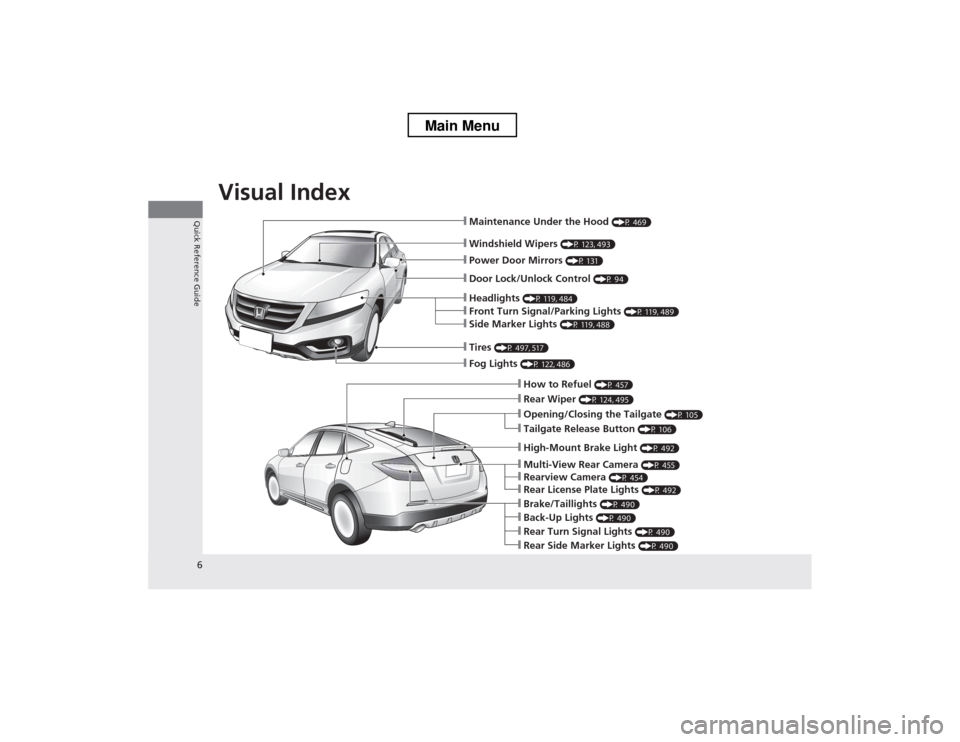
Visual Index
6
Quick Reference Guide
❙Windshield Wipers (P 123, 493)
❙Maintenance Under the Hood (P 469)
❙Fog Lights (P 122, 486)
❙Front Turn Signal/Parking Lights (P 119, 489)
❙Side Marker Lights (P 119, 488)
❙Tires (P 497, 517)
❙How to Refuel (P 457)
❙Opening/Closing the Tailgate (P 105)
❙Rear Wiper (P 124, 495)
❙Back-Up Lights (P 490)
❙Brake/Taillights (P 490)
❙Rear Turn Signal Lights (P 490)
❙Rear Side Marker Lights (P 490)
❙Multi-View Rear Camera (P 455)
❙Rearview Camera (P 454)
❙Rear License Plate Lights (P 492)
❙Headlights (P 119, 484)
❙Power Door Mirrors (P 131)
❙Door Lock/Unlock Control (P 94)
❙High-Mount Brake Light (P 492)
❙Tailgate Release Button (P 106)
Main Menu
Page 9 of 573
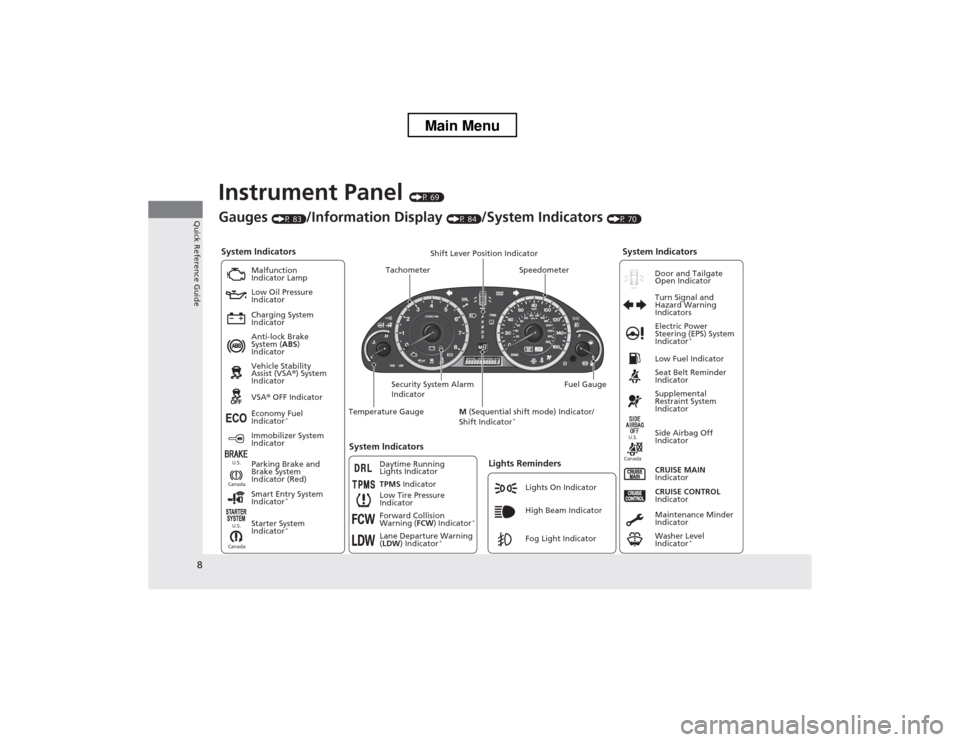
8
Quick Reference Guide
Instrument Panel (P 69)
System Indicators
Malfunction
Indicator Lamp
Low Oil Pressure
Indicator
Charging System
Indicator Anti-lock Brake
System ( ABS)
Indicator Vehicle Stability
Assist (VSA ®) System
Indicator VSA ® OFF Indicator
Low Tire Pressure
IndicatorLights Reminders
Lights On Indicator
High Beam Indicator
Fog Light Indicator
Immobilizer System
Indicator
Seat Belt Reminder
Indicator
System Indicators
CRUISE CONTROL
Indicator
Parking Brake and
Brake System
Indicator (Red) Supplemental
Restraint System
Indicator
Side Airbag Off
Indicator
CRUISE MAIN
Indicator
Tachometer Speedometer
Fuel Gauge
Security System Alarm
Indicator Shift Lever Position Indicator
Low Fuel Indicator
Gauges
(P 83)/Information Display (P 84)/System Indicators (P 70)
Economy Fuel
Indicator *
TPMS Indicator
Maintenance Minder
Indicator
Washer Level
Indicator*
Temperature Gauge
Electric Power
Steering (EPS) System
Indicator
*
Turn Signal and
Hazard Warning
Indicators
System Indicators
Canada U.S.Canada
U.S.
Starter System
Indicator
* Door and Tailgate Open Indicator
Smart Entry System
Indicator *
Canada U.S.Forward Collision
Warning (
FCW) Indicator *
Lane Departure Warning ( LDW ) Indicator *
M
(Sequential shift mode) Indicator/
Shift Indicator *
Daytime Running
Lights Indicator
Main Menu
Page 19 of 573

18
Quick Reference Guide
Driving (P409)
Release ButtonShift Lever
Automatic Transmission
(P426, 428)
● Shift to
(P and depress the brake pedal when starting the engine.
Shifting
Park
Turn off or start the engine.
Transmission is locked.
Reverse Used when reversing.
Neutral
Transmission is not locked.
Drive
Normal driving.
On models with paddle shifter,
D-paddle shift mode can be used. Drive (D3)
Used when:
Page 21 of 573

20
Quick Reference Guide
Maintenance (P 461)
Under the Hood (P 469)
● Check engine oil, engine coolant, and windshield washer
fluid. Add when necessary.
● Check brake fluid.
● Check the battery regularly.
a Pull the hood release handle under the corner of the
dashboard.
b Locate the hood latch lever, pull the lever up, and lift up
the hood.
c When finished, close the hood and make sure it is firmly
locked in place.
Lights (P 484)
● Inspect all lights regularly.
Wiper Blades
(P 493)
● Replace blades if they leave streaks
across the windshield.
Tires (P 497)
● Inspect tires and wheels regularly.
● Check tire pressures regularly.
● Install snow tires for winter
driving.
Main Menu
Page 23 of 573

22
Quick Reference Guide
What to Do If
*1:Models with the smart entry system have an ENGINE START/STOP button instead of an ignition switch.
The ignition switch does
not turn from
(0 to (q*1
.
Why?
● The steering wheel may be locked.
● Try to turn the steering wheel left and right
while turning the ignition key *
.
● Move the steering wheel left and right while
pressing the ENGINE START/STOP button*
at
the same time.
The ignition switch does
not turn from
(q to (0*1
and I cannot remove the
key. Why?
The shift lever should be moved to (P .
Why does the brake pedal
pulsate slightly when
applying the brakes?This can occur when the ABS activates, and does not indicate a
problem. Apply firm, steady pressure on the brake pedal. Never
pump the brake pedal.
The rear door cannot be
opened from inside the
vehicle. Why?Check if the childproof lock is in the
lock position. If so, open the rear
door with the outside door handle.
To cancel this function, push the
lever to the unlock position.
Main Menu
Page 25 of 573
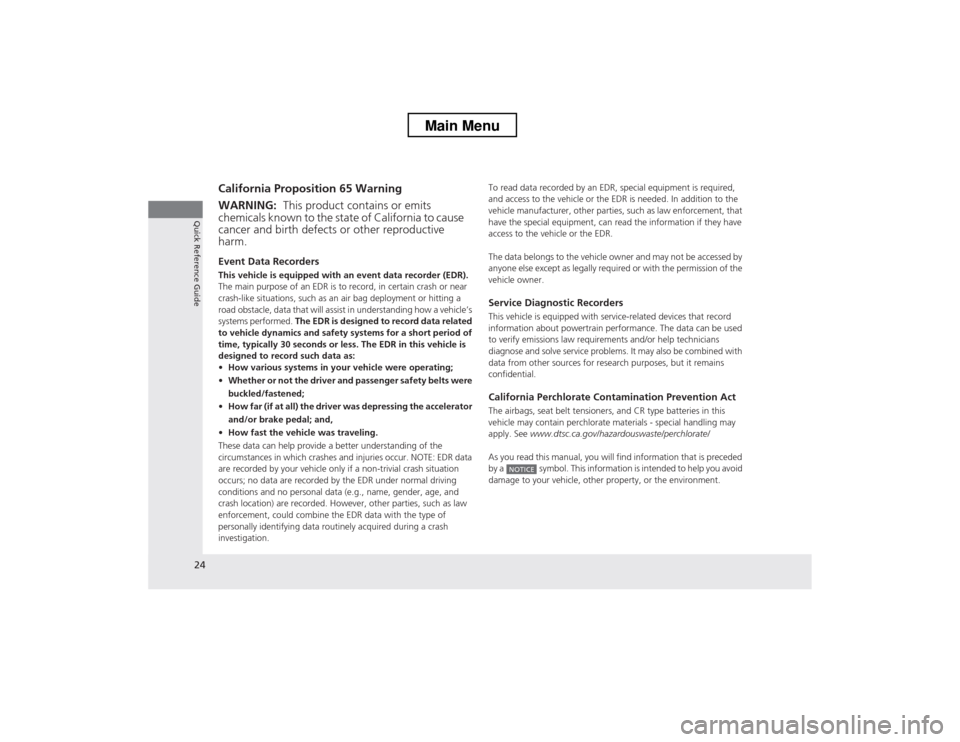
24
Quick Reference Guide
California Proposition 65 Warning
Event Data Recorders
This vehicle is equipped with an event data recorder (EDR).
The main purpose of an EDR is to record, in certain crash or near
crash-like situations, such as an air bag deployment or hitting a
road obstacle, data that will assist in understanding how a vehicle’s
systems performed. The EDR is designed to record data related
to vehicle dynamics and safety systems for a short period of
time, typically 30 seconds or less. The EDR in this vehicle is
designed to record such data as: • How various systems in yo ur vehicle were operating;
• Whether or not the driver and passenger safety belts were
buckled/fastened;
• How far (if at all) the driver was depressing the accelerator
and/or brake pedal; and,
• How fast the vehicle was traveling.
These data can help provide a better understanding of the
circumstances in which crashes and injuries occur. NOTE: EDR data
are recorded by your vehicle only if a non-trivial crash situation
occurs; no data are recorded by the EDR under normal driving
conditions and no personal data (e.g., name, gender, age, and
crash location) are recorded. However, other parties, such as law
enforcement, could combine the EDR data with the type of
personally identifying data routinely acquired during a crash
investigation.
WARNING: This product contains or emits
chemicals known to the state of California to cause
cancer and birth defects or other reproductive harm.
To read data recorded by an EDR, special equipment is required,
and access to the vehicle or the EDR is needed. In addition to the
vehicle manufacturer, other parties, such as law enforcement, that
have the special equipment, can read the information if they have
access to the vehicle or the EDR.
The data belongs to the vehicle owner and may not be accessed by
anyone else except as legally required or with the permission of the
vehicle owner.
Service Diagnostic Recorders
This vehicle is equipped with service-related devices that record
information about powertrain performance. The data can be used
to verify emissions law requirements and/or help technicians
diagnose and solve service problems. It may also be combined with
data from other sources for research purposes, but it remains confidential.
California Perchlorate Conta mination Prevention Act
The airbags, seat belt tensioners, and CR type batteries in this
vehicle may contain perchlorate materials - special handling may apply. See www.dtsc.ca.gov/hazardouswaste/perchlorate/
As you read this manual, you will find information that is preceded
by a symbol. This information is intended to help you avoid
damage to your vehicle, other property, or the environment.
NOTICE
Main Menu
Page 71 of 573
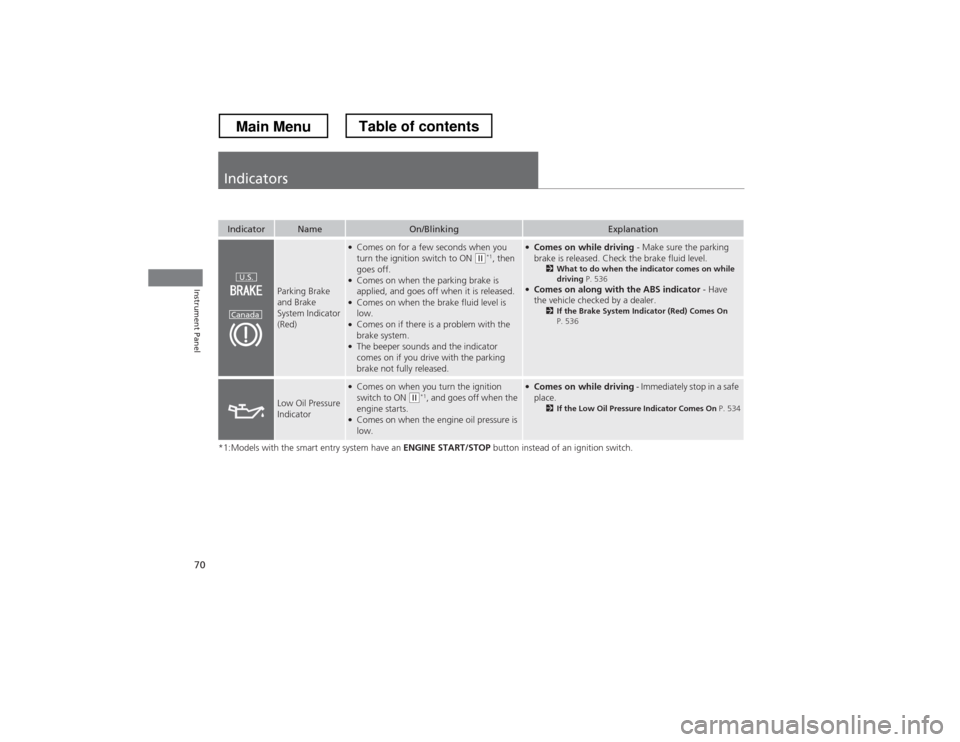
70
Instrument Panel
Indicators
*1:Models with the smart entry system have an ENGINE START/STOP button instead of an ignition switch.
IndicatorNameOn/BlinkingExplanation
Parking Brake and Brake
System Indicator (Red)
●
Comes on for a few seconds when you
turn the ignition switch to ON
(w *1
, then
goes off.
● Comes on when the parking brake is
applied, and goes off when it is released.
● Comes on when the brake fluid level is
low.
● Comes on if there is a problem with the
brake system.
● The beeper sounds and the indicator
comes on if you drive with the parking
brake not fully released.
● Comes on while driving - Make sure the parking
brake is released. Check the brake fluid level. 2What to do when the indicator comes on while
driving P. 536
● Comes on along with the ABS indicator - Have
the vehicle checked by a dealer. 2If the Brake System Indicator (Red) Comes On
P. 536
Low Oil Pressure
Indicator
● Comes on when you turn the ignition
switch to ON
(w *1
, and goes off when the
engine starts.
● Comes on when the engine oil pressure is
low.
● Comes on while driving - Immediately stop in a safe
place. 2If the Low Oil Pressure Indicator Comes On P. 534
U.S.
Canada
Main MenuTable of contents
Page 74 of 573
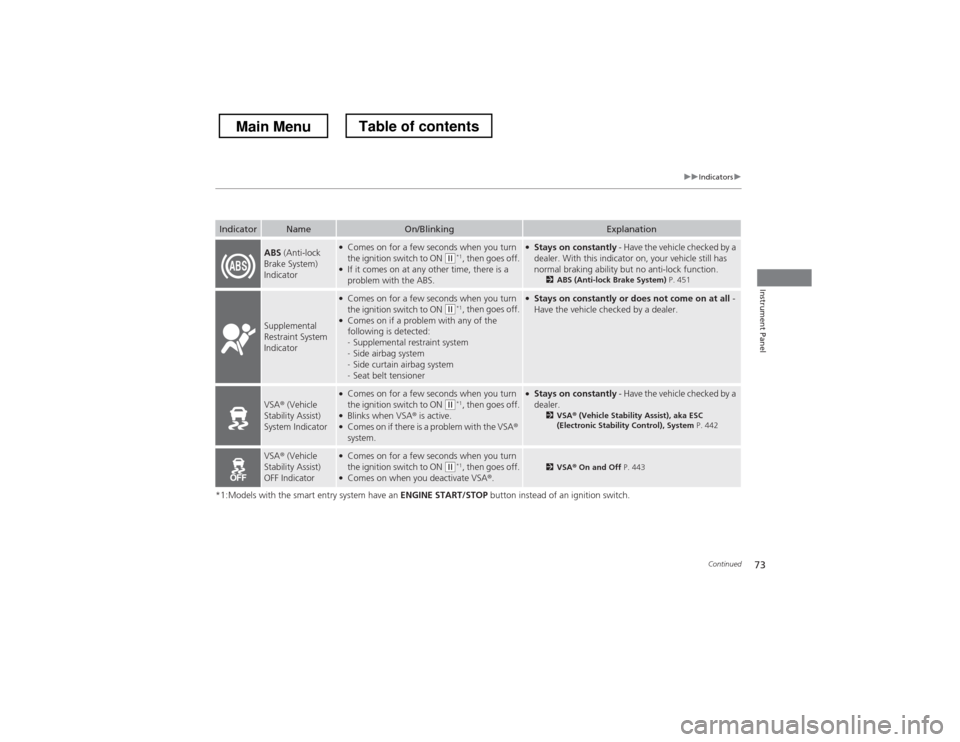
73
uuIndicatorsu
Continued
Instrument Panel
*1:Models with the smart entry system have an ENGINE START/STOP button instead of an ignition switch.
IndicatorNameOn/BlinkingExplanation
ABS (Anti-lock
Brake System)
Indicator● Comes on for a few seconds when you turn
the ignition switch to ON
(w *1
, then goes off.
● If it comes on at any other time, there is a
problem with the ABS.
●Stays on constantly - Have the vehicle checked by a
dealer. With this indicator on, your vehicle still has
normal braking ability but no anti-lock function. 2ABS (Anti-lock Brake System) P. 451
Supplemental
Restraint System
Indicator
●
Comes on for a few seconds when you turn
the ignition switch to ON
(w *1
, then goes off.
● Comes on if a problem with any of the
following is detected:-Supplemental restraint system
- Side airbag system
- Side curtain airbag system
- Seat belt tensioner
●
Stays on constantly or does not come on at all -
Have the vehicle checked by a dealer.
VSA ® (Vehicle
Stability Assist)
System Indicator
● Comes on for a few seconds when you turn
the ignition switch to ON
(w *1
, then goes off.
● Blinks when VSA ® is active.
● Comes on if there is a problem with the VSA ®
system.
● Stays on constantly - Have the vehicle checked by a
dealer. 2VSA ® (Vehicle Stability Assist), aka ESC
(Electronic Stability Control), System P. 442
VSA® (Vehicle
Stability Assist)
OFF Indicator● Comes on for a few seconds when you turn
the ignition switch to ON
(w *1
, then goes off.
● Comes on when you deactivate VSA ®.2 VSA ® On and Off P. 443
Main MenuTable of contents